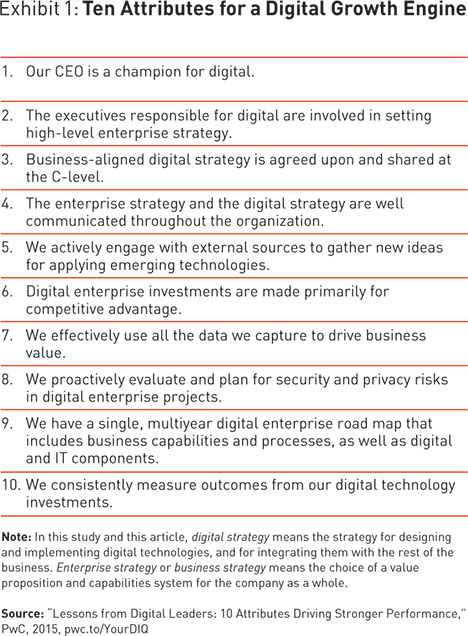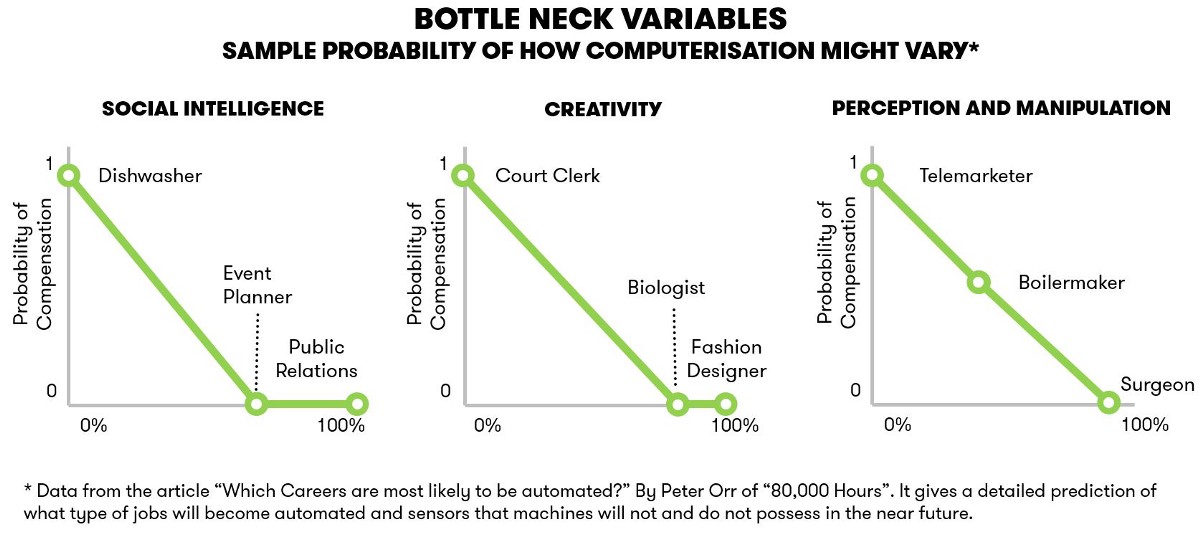-
« What exactly that means is not the same for every business, nor should it be. Thus, if you are a senior executive developing a digital strategy, the first thing you need is a way to gauge whether that strategy is smart: whether it puts today’s technology to work in an appropriately advanced way, while being a good fit for your overall strategy and your way of doing business. In short, you need to check your Digital IQ — and if necessary, to raise it. »
-
They have already used technology to improve productivity and wring out costs. Now they are using it to grow revenue, create compelling customer experiences, and build the kinds of distinctive capabilities that lead to ongoing success.
-
-
-
-
• New spending patterns. Budgets are shifting to reflect the new realities in IT: lower costs with cloud-based services, digital technology that permeates every aspect of the business, and business leaders’ increased awareness of the art of the possible.
-
• New digital leadership. Enterprise technology used to be the sole domain of the IT function, led by the CIO. Now there is a trend toward broader-based oversight. Some companies are expanding the CIO role to foster a more direct connection between technology and strategy. Other companies are creating a chief digital officer (CDO) or similar role to lead digital transformation efforts. In some companies, titles for leaders who oversee digital strategy include the chief experience officer and chief data scientist.
-
• A new digital debate. Every company has its own point of view about the value of digital technology and how it should be managed. Some of the executives we surveyed define digital as activities related only to the innovation of products and services.
-
How to Activate Your Digital Growth Engine
How can you use Digital IQ to create competitive advantage? Consider these practices:
1. Diagnose your company. First, capture your own personal sense of where your company stands, for example, with the online assessment at pwc.to/YourDIQ. Then, retake the assessment with your business and IT leadership team. Look for gaps: For example, you may find, as one large industrial company did, that you are far ahead in managing cybersecurity and data analytics — but surprisingly behind in the way you communicate and develop your shared digital vision.
2. Conduct a digital strategy workshop. Bring together key leaders from around the enterprise to look at the results of your diagnosis, and to discuss the next wave of digital investments. Use the same workshop to raise awareness of other relevant issues, such as lack of coordination in your technology spending.
3. Start a digital dialogue. Use technology — video, internal social media, and mobile — to engage large numbers of employees about the digital strategy and ways to implement it.
4. Develop a disruption strategy. Look for customers who are not served by your current offerings. Take on the challenge of using digital technology to create a spin-off that meets the needs of these customers or matches their price point. If Clayton Christensen is right, this spin-off approach could grow one day to challenge your main business.
5. Expand your ecosystem. Digital innovation is emerging from places your organization may not frequent, such as startup incubators, university labs, open source projects, and “maker” communities. Build new relationships with these sources of knowledge to keep your ideas and skills fresh and flowing.
6. Shake up your leadership. Create or reshuffle your organizational roles so that the CIO, CMO, head of operations, and even CFO are aligned to the digital needs of your company. If need be, put a CDO (or equivalent) in place to tie all your initiatives together.
-
Immelt has famously said that digitization will affect every corner of the economy, that every industrial company will soon be a software and analytics company, and that GE’s digital transformation is the company’s most important initiative since the mid-1980s.
-
At GE, two C-suite positions are devoted to the strategic use of digital technology. Chief digital officer Bill Ruh (in a role recently created) oversees digital business, which is what the company calls its line of industrial services and software, and CIO Jim Fowler manages the internal innovation required to generate new products and reinvent the company’s operations.
-
The resulting Industrial Internet, as it is increasingly called, has led to a number of rapid successes in large-scale digital technology, making every aspect of operations more flexible, interoperable, and self-aware. GE and Southwest Airlines, for instance, are pioneering a data analytics effort based on cloud computing, showing how every detail adds to or detracts from an airplane’s performance.
-
-
Artificial Intelligence and the Future of Work
« There’s no doubt that Strong AI is the subject of intense research by DARPA, MIT, Berkeley, IBM, Google and many others. But it’s hard not to notice that despite all the anxiety, Strong AI today lives only in the imagination of science fiction writers and in the hopes and dreams of research scientist. At the prestigious “Future of AI” conference in San Juan this January, the estimates for when an AI might emerge vacillated wildly from 5 years to a hundred years in our future — its variables are that unknown. »
-
GoDaddy’s vision is to radically shift the global economy toward small business by empowering people to easily start, confidently grow and successfully run their own ventures. We didn’t come to that vision by chance, but rather by identifying the intersection of technological and global economic opportunities — and Applied AI is at the heart of both.
-
Economically, we see a future where enterprise business becomes increasingly efficient by automating much of their workforce using AAI.
-
The tsunami of social change that will follow presents an incredible opportunity for those, like GoDaddy, who will help people transition from automatable roles into work that is non-susceptible to computerization
-
-
Non-creative jobs that don’t require a high level of social intelligence or complex manipulation (like a surgeon) will be highly susceptible to computerizaion.
-
We’re is beginning to help entrepreneurs wear fewer hats by using AAI to deliver hyper-personalized business insights that take the time and weight out of previously cripplingly daunting decisions.
-
-
Cisco’s John Chambers on the digital era | McKinsey & Company
« How significant is the digital era? It’s the biggest technology transition in history, according to Cisco’s executive chairman—and requires a proportional response from companies. «
-
As leaders, if you don’t transform and use this technology differently—if you don’t reinvent yourself, change your organization structure; if you don’t talk about speed of innovation—you’re going to get disrupted.
-
Probably 40 percent of enterprise customers around the world will not exist in a meaningful way ten years from now
-
So you’ve got technologies like cloud or mobility and cybersecurity and the Internet of Things that are very important. That’s actually the easy part.
-
The hard part is how do you change your organization structure? How do you change your culture to be able to think in terms of outcomes for your customers?
-
Today, you’re talking about digitization being an integral part of the fabric of a company’s business strategy or the way it interfaces its supply chain with its customers. Not enabled by technology—technology will become the company.
-
Focus more horizontally on how things work together as opposed to silos. If all you do is have a bunch of silos in your company that don’t really talk to each other, you’re going to get displaced by, perhaps, a small company that has just a CEO and a CIO and has $1 billion in sales
-
Yet we changed 41 percent of the client interface and execs because they were selling routers and switching technology, not business outcomes, architectures, and speed-to-market delivery.
-
And it caused us to change our top leadership. We changed probably 40 percent of our top leadership over the last two years.
-
We’ve done 184 acquisitions. We use M&A as a way to enter new markets, and we’re number one or number two in 16 major product families.
-
-
In the Information Age, We Need Brain-Based Enterprises
« Enterprises based on brainpower therefore need to understand higher-order business questions of leadership, innovation, and creativity to stay ahead. Questions such as: »
-
- Where do creativity and imagination come from at a personal level? How can you make collective creativity work? What part do tools and techniques for divergent and convergent thinking play in the mix?
- What kind of leadership is required to make innovation and creativity “business as usual” in your enterprise?
- What ensures creativity turns into innovation? What stops it?
- What are BBEs really doing beneath the veneer?
- How do culture and structure support or limit innovation and creativity? What can we do about it? How may we become a genuine learning enterprise?
-
- Creativity is the thinking of novel ideas
- Innovation is the conversion of a novel idea into a profitable or sustainable product/service or process
-
-
A good business strategy therefore allows for responsiveness and agility, and this requires creative responses to opportunities which are consistent with the general direction of travel. It also requires the consideration of the appropriateness of ideas rather than just novelty per se.
-
“With thought and care” is my starter on this. Many creative people refuse to be managed, but they can be led.
-
We need a much more organic/biological outlook on organization development than an industrial/process model if we are to create enterprises which think, learn, adapt, and respond to a changing environment.
-
It’s one thing to be personally creative. It’s quite another to create a culture where creativity and innovation are embedded into the “corporate corpuscles” of the enterprise
-
BBEs are not just concerned with encouraging individuals to bring their minds, bodies, and souls to work. They make collective creativity and innovation work at the enterprise level.
-
BBEs do this by encouraging a culture of intrapreneurship and through the use of formal and informal strategies and tools for divergent and convergent thinking.
-
BBEs often manage to pull off the clever trick of making a large enterprise feel like a small one, where people can combine their passions with a purpose. To do complex things in a large enterprise, the organizational design principle of simplicity must be used.
Découvrez le livre que nous avons co-écrit avec 7 autres experts avec pleins de retours d'expérience pour aider managers et dirigeants




